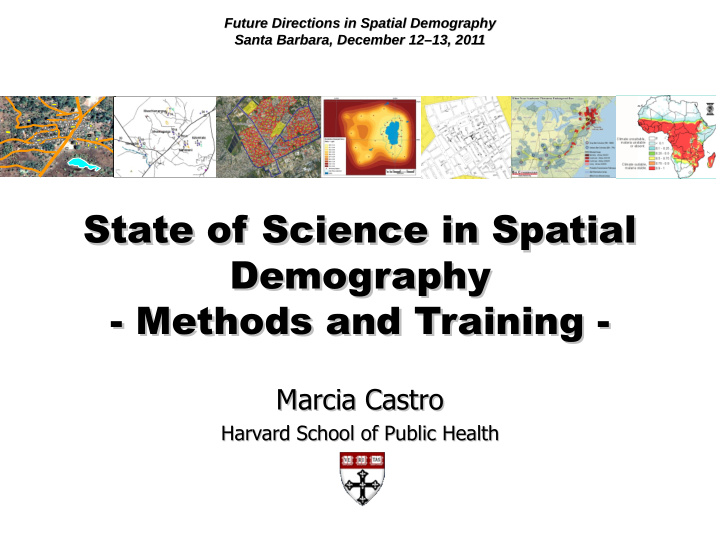



Future Directions in Spatial Demography Future Directions in Spatial Demography Santa Barbara, December 12–13, 2011 Santa Barbara, December 12–13, 2011 State of Science in Spatial State of Science in Spatial Demography Demography - Methods and Training - - Methods and Training - Marcia Castro Marcia Castro Harvard School of Public Health Harvard School of Public Health
Contributions Contributions Applications have been growing Applications have been growing Availability of spatial data Availability of spatial data Availability of computer programs and computer Availability of computer programs and computer capabilities to store and analyze large datasets capabilities to store and analyze large datasets The importance of spatially targeted policies The importance of spatially targeted policies Growing interest in assessing the social context Growing interest in assessing the social context for a variety of demographic outcomes - for a variety of demographic outcomes - scrutinize the importance of community and scrutinize the importance of community and neighborhood effects neighborhood effects Development of spatial thinking among the Development of spatial thinking among the social sciences social sciences
Spatial Demography 1. Methods Methods for spatial demography 1. for spatial demography 2. Training Training of demographers on these 2. of demographers on these methods methods
Part 1 Part 1 Methods Methods
Applications Applications Identify or confirm regional patterns: Identify or confirm regional patterns: Distribution Distribution Clustering Clustering Inequalities Inequalities Model spatio-temporal changes & inform Model spatio-temporal changes & inform predictive models predictive models Targeted interventions Targeted interventions Generate the demand for data, models, Generate the demand for data, models, software software
Publishing venues Mostly: Mostly: Stats, Public health, Geography Stats, Public health, Geography A change is coming… A change is coming…
Methodological Challenges Methodological Challenges Results are scale dependent – MAUP Results are scale dependent – MAUP Data are not always appropriate for spatial Data are not always appropriate for spatial analysis due to the sampling frame and/or analysis due to the sampling frame and/or spatial coverage spatial coverage Combining data from different sources Combining data from different sources Establish a sound conceptual framework Establish a sound conceptual framework Models that assess causality Models that assess causality Micro vs. Macro studies Micro vs. Macro studies
Part 2 Part 2 Training Training
What is available? Most of the universities that host a Most of the universities that host a population center (Association of population center (Association of Population Centers) do not have a Population Centers) do not have a Geography department Geography department Some universities have a GIS center that Some universities have a GIS center that provide classes on ArcGis provide classes on ArcGis Only a handful of programs provide Only a handful of programs provide training on spatial analytical techniques training on spatial analytical techniques Teaching methods vs. Teaching software Teaching methods vs. Teaching software
What are we missing? “Spatial Thinking” Spatial Thinking” “ Prior to college/graduate school Prior to college/graduate school “Seeds to populate the network” Seeds to populate the network” “ Who will provide the training? Who will provide the training? A core curriculum A core curriculum e.g., Applied Demography e.g., Applied Demography What is spatial demography? What is spatial demography? What should be taught? What should be taught?
Recommend
More recommend